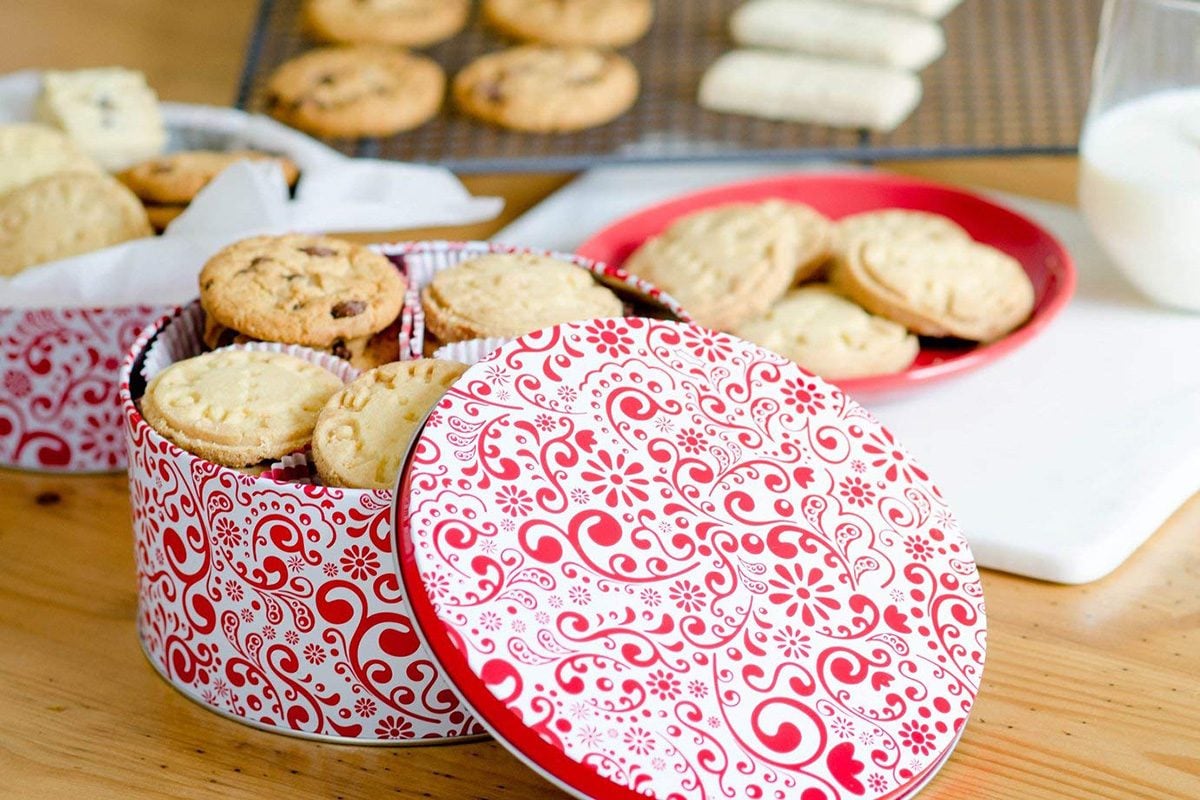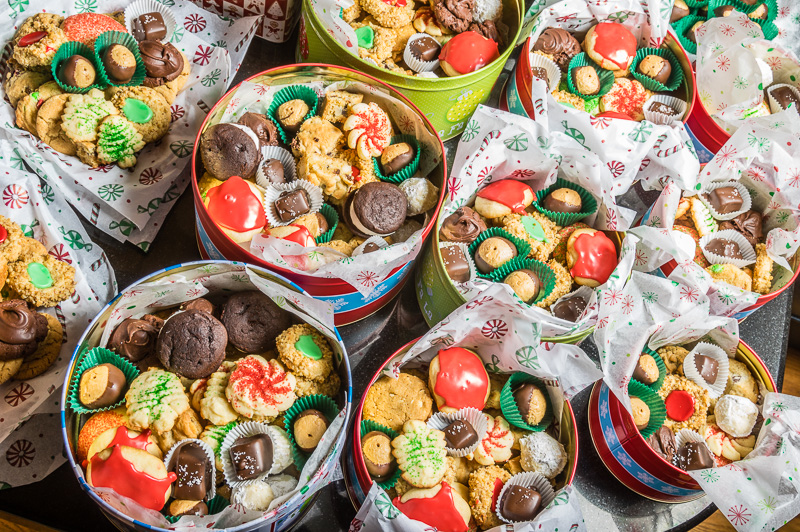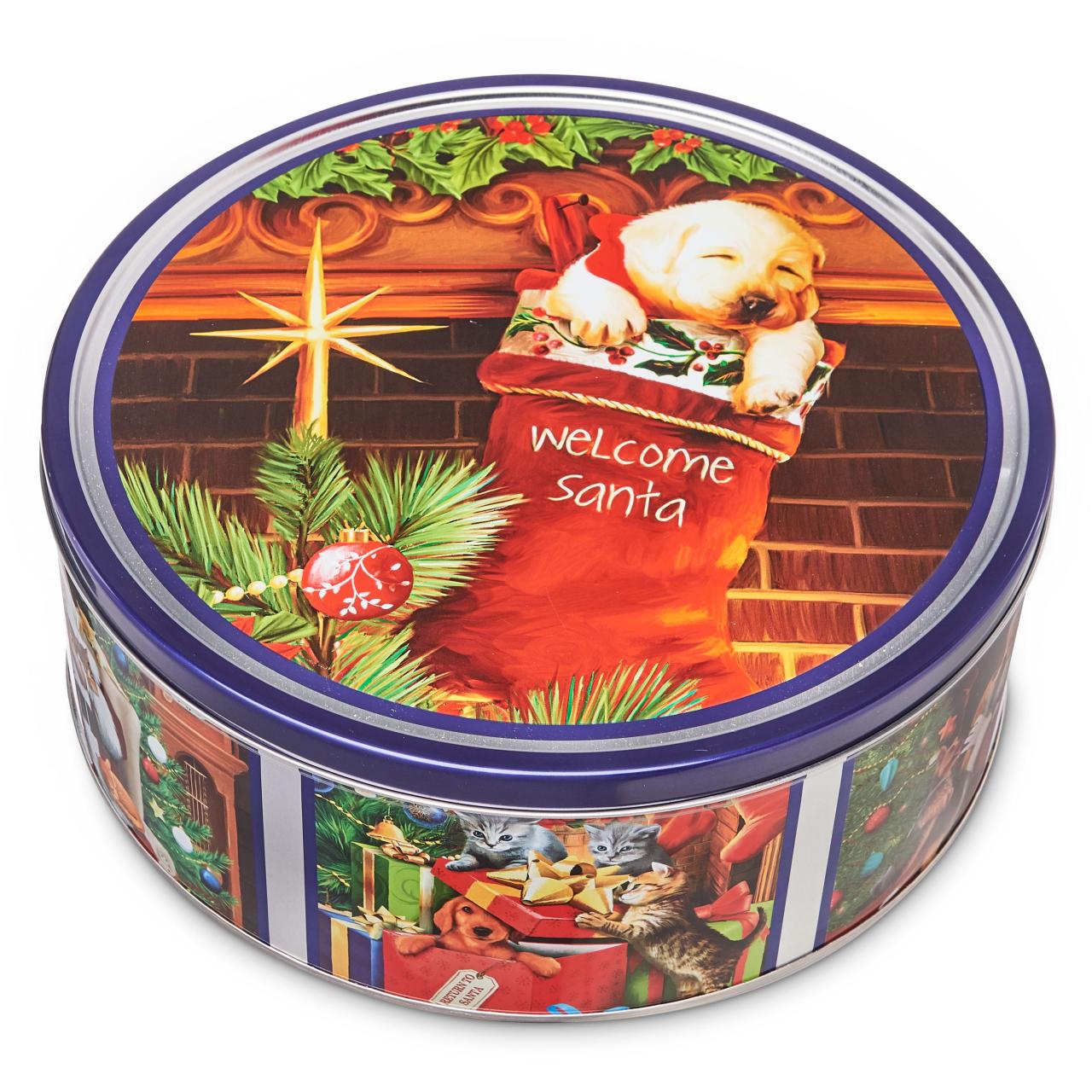Christmas cookies in a tin: the very phrase conjures images of festive gatherings, the aroma of warm spices, and the joy of sharing holiday treats. This isn’t just about delicious cookies; it’s a tradition steeped in history, artistry, and the enduring spirit of Christmas. From the evolution of the tins themselves – their materials, designs, and shapes – to the countless varieties of cookies nestled within, we’ll explore the rich tapestry of this beloved holiday custom. We’ll delve into the art of gifting these sweet treasures, exploring the cultural significance and the simple joy of presenting a beautifully decorated tin filled with homemade goodness.
This exploration will cover the historical context of Christmas cookie tins, showcasing their evolution from simple containers to elaborate works of art. We’ll examine the popular types of cookies frequently found in these tins, highlighting their unique flavors and textures. Furthermore, we’ll delve into the design elements that adorn these tins, the artistry involved in their creation, and the modern trends shaping the future of this delightful tradition. Get ready for a delicious journey through time and tradition!
The History of Christmas Cookies in Tins

The tradition of gifting Christmas cookies, often nestled within decorative tins, is a delightful custom with a rich history. While pinpointing the exact origin is difficult, the practice likely evolved alongside the increasing popularity of both baked goods and mass-produced metal containers during the late 19th and early 20th centuries. The combination of delicious treats and attractive packaging created a perfect gift-giving solution for the holiday season.
Evolution of Christmas Cookie Tins
The earliest forms of Christmas cookie containers were likely simple, utilitarian tins, perhaps repurposed from other goods. As mass production techniques improved, manufacturers began creating tins specifically for holiday use. Early designs were often simple, featuring basic festive imagery such as holly, snow, or Santa Claus. Over time, designs became more elaborate, incorporating vibrant colors, intricate illustrations, and even three-dimensional elements. Modern tins range from nostalgic reproductions of vintage designs to sleek, contemporary styles, reflecting changing tastes and artistic trends. The evolution reflects both technological advancements in tin manufacturing and shifting cultural preferences in gift-giving.
Historical Significance of Gifting Cookies in Tins
Gifting cookies in tins became increasingly common as a practical and festive way to share holiday cheer. The tin itself added a layer of value beyond the cookies, transforming a simple gift into a more memorable and reusable item. The tins often became cherished keepsakes, used year after year to store holiday decorations or other treasured items. This practice fostered a sense of tradition and nostalgia, enhancing the overall Christmas experience. The act of giving cookies in tins became a symbol of goodwill and festive generosity.
Types of Tins Used Throughout History
Early Christmas cookie tins were often made of plain tinplate, sometimes decorated with simple lithographed designs. Later, more durable and decorative materials like lacquered tin, enamelware, and even lithographed cardboard boxes were used. Shapes and sizes varied considerably, ranging from small, round tins to larger, rectangular or uniquely shaped containers. Some tins were even designed to be stacked or nested, optimizing storage and transportation. The choice of material and design often reflected the cost and availability of resources, as well as the intended recipient and the occasion.
Examples of Vintage Christmas Cookie Tins
Vintage Christmas cookie tins offer a fascinating glimpse into the past. Their designs often reflect the popular aesthetics and cultural trends of their time. Many are highly collectible today due to their rarity and artistic merit.
| Tin Type | Material | Design Features | Approximate Year |
|---|---|---|---|
| Round Tin | Lithographed Tinplate | Depiction of Santa Claus and reindeer flying over a snowy landscape, red and green color scheme | 1950s |
| Rectangular Tin | Lacquered Tin | Intricate illustration of a Christmas village scene with snow-covered houses and carolers, gold accents | 1930s |
| Oval Tin | Enamelware | Simple design featuring holly sprigs and berries on a white background, embossed lettering | 1940s |
| Square Tin | Lithographed Cardboard | Image of a Christmas tree decorated with ornaments and lights, vibrant colors | 1960s |
Types of Christmas Cookies Commonly Found in Tins: Christmas Cookies In A Tin

Christmas cookie tins are a festive tradition, brimming with a delightful variety of sweet treats. These tins often contain a curated selection of classic and sometimes unique cookies, offering a diverse range of flavors and textures to satisfy every palate. The cookies themselves are carefully chosen for their ability to hold up well during transport and storage, maintaining their deliciousness for weeks.
A Diverse Selection of Christmas Cookies, Christmas cookies in a tin
Many factors influence which cookies make their way into a Christmas cookie tin, including shelf life, ease of transport, and overall festive appeal. Below are ten popular choices, each with its own unique characteristics.
- Sugar Cookies: These buttery, melt-in-your-mouth cookies are a staple. Their simple base allows for endless variations in flavor (vanilla, cinnamon, peppermint) and decoration (icing, sprinkles). The texture is typically soft and slightly crisp.
- Gingerbread Cookies: Known for their warm, spicy flavor profile (ginger, cinnamon, cloves), gingerbread cookies are often decorated with icing and candies. Their texture can range from soft and chewy to firm and crisp, depending on the recipe.
- Shortbread Cookies: These crumbly, buttery cookies are incredibly rich and melt in the mouth. Their simple ingredient list (butter, sugar, flour) allows the high butter content to shine through. The texture is distinctly crumbly and delicate.
- Peanut Butter Blossoms: These cookies feature a peanut butter base, topped with a Hershey’s Kiss, creating a delightful combination of salty and sweet. The texture is soft and chewy, with a slightly crispy edge.
- Chocolate Crinkle Cookies: These intensely chocolatey cookies have a characteristic crackled exterior, achieved through a coating of powdered sugar. The interior is fudgy and moist, offering a delightful textural contrast.
- Snickerdoodles: Cinnamon-sugar coated, these cookies have a soft and chewy texture with a warm, comforting spice flavor. They are a classic choice for their simplicity and pleasing taste.
- Biscotti: Twice-baked, these crisp cookies are perfect for dipping in coffee or hot chocolate. They come in various flavors, often incorporating nuts, dried fruits, and spices. Their texture is firm and crunchy.
- Thumbprint Cookies: These small cookies feature a slightly indented center, often filled with jam, preserves, or chocolate. The texture is typically soft and buttery, with a slight crispness around the edges.
- Pfeffernüsse: These traditional German spice cookies are characterized by their dense texture and intense flavor profile. They are often spiced with cinnamon, cloves, and cardamom, and have a slightly chewy texture.
- Mexican Wedding Cookies: These melt-in-your-mouth cookies are coated in powdered sugar, giving them a delicate, snowy appearance. They are rich and buttery, with a tender, crumbly texture.
A Visual Representation of Christmas Cookie Tin Variety
Imagine a vibrant assortment of cookies arranged in a festive tin. In the foreground, a cluster of colorful sugar cookies, decorated with swirls of bright icing and rainbow sprinkles, contrasts with the warm brown tones of several gingerbread men, meticulously iced with intricate designs. Next to them, the pale golden hue of shortbread cookies, their edges slightly browned, stands out. A few peanut butter blossoms, their chocolate kisses gleaming, nestle amongst the others. The deep brown, crackled surface of chocolate crinkle cookies contrasts sharply with the pale, cinnamon-dusted snickerdoodles. In the back, a few biscotti, their edges slightly darker from the double baking, add a touch of rustic charm. Smaller thumbprint cookies, with their colorful jam fillings peeking through, are scattered amongst the larger cookies. A few pfeffernüsse, their dark brown color hinting at their intense spices, add a touch of old-world charm. Finally, the cloud-like texture of Mexican wedding cookies, completely dusted in powdered sugar, complete the array. The overall effect is one of cheerful abundance, reflecting the joy and warmth of the Christmas season. The textures range from soft and chewy to crisp and crunchy, promising a diverse sensory experience. The colors are equally varied, ranging from pale golds and browns to vibrant reds, greens, and blues.
The Art and Design of Christmas Cookie Tins

Christmas cookie tins are more than just containers; they’re miniature works of art, often treasured as much for their festive designs as for the delicious treats they hold. The artistry and craftsmanship involved in their creation contribute significantly to the overall holiday experience, transforming a simple act of storing cookies into a charming tradition.
The aesthetic appeal of Christmas cookie tins stems from a blend of artistic styles, materials, and manufacturing processes. These tins represent a confluence of artistic expression and practical function, reflecting evolving trends in design and manufacturing techniques over the years.
Artistic Styles and Themes on Christmas Cookie Tins
Christmas cookie tins showcase a wide array of artistic styles, reflecting the ever-evolving trends in visual art and design. From classic depictions of Santa Claus and snow-covered landscapes to more modern interpretations of holiday imagery, the designs are as diverse as the cookies they contain. Many tins incorporate nostalgic elements, evoking feelings of warmth and tradition, while others embrace contemporary aesthetics with bold colors and abstract patterns. The choice of style often depends on the target audience and the brand’s overall aesthetic. For example, a tin aimed at children might feature bright, cartoonish characters, while a tin for adults might opt for a more sophisticated, minimalist design.
Materials Used in Creating Christmas Cookie Tins
The majority of Christmas cookie tins are made from metal, specifically tinplate, a thin sheet of steel coated with tin to prevent rust and corrosion. Tinplate is a cost-effective and durable material, well-suited for mass production. However, some higher-end tins might be made from other materials, such as lithographed steel which allows for more vibrant and detailed printing, or even ceramic, offering a more substantial and collectible feel. The choice of material influences not only the tin’s durability and appearance but also its cost and the printing techniques that can be employed.
Design and Manufacturing Processes
The design and manufacturing of Christmas cookie tins is a multi-stage process. It begins with the conceptualization of the design, often involving graphic designers and artists who create the artwork. This artwork is then prepared for printing, often using lithographic printing techniques which allow for intricate detail and vibrant colors. The printed images are then applied to the tinplate sheets, which are subsequently cut, formed, and assembled into the final tin shape. The process involves specialized machinery and skilled technicians to ensure the tins are both aesthetically pleasing and structurally sound. Quality control checks are performed at various stages to maintain consistency and high standards.
Common Design Elements on Christmas Cookie Tins
The visual elements found on Christmas cookie tins are diverse, reflecting a broad range of holiday themes and artistic styles. These elements often work together to create a cohesive and festive overall design.
- Holiday Scenes: Depictions of winter landscapes, snow-covered houses, Christmas trees, and festive gatherings are classic themes. These scenes often evoke a sense of nostalgia and traditional holiday spirit.
- Holiday Characters: Santa Claus, elves, reindeer, snowmen, and other iconic Christmas characters are frequently featured. The style of these characters can range from traditional and realistic to whimsical and cartoonish.
- Patterns and Textures: Geometric patterns, snowflakes, plaid designs, and other textures add visual interest and contribute to the overall festive atmosphere. These patterns can be used as backgrounds or incorporated into larger designs.
- Animals: Reindeer, polar bears, penguins, and other animals associated with winter and the holiday season are often included, adding a touch of whimsy or realism depending on the artistic style.
- Calligraphy and Typography: Elegant fonts and festive lettering are often used to convey holiday greetings or brand names. The choice of font can significantly impact the overall aesthetic of the tin.